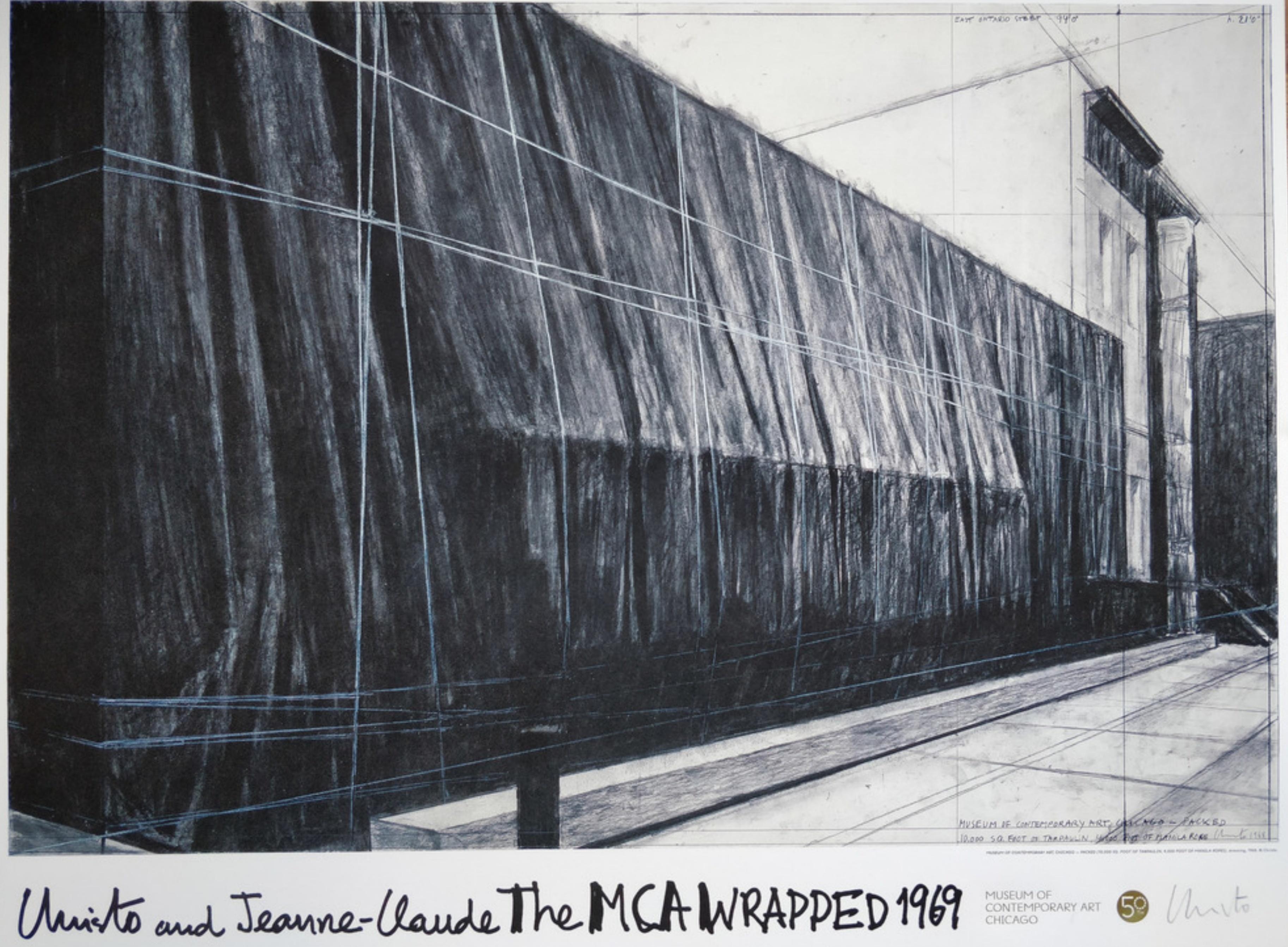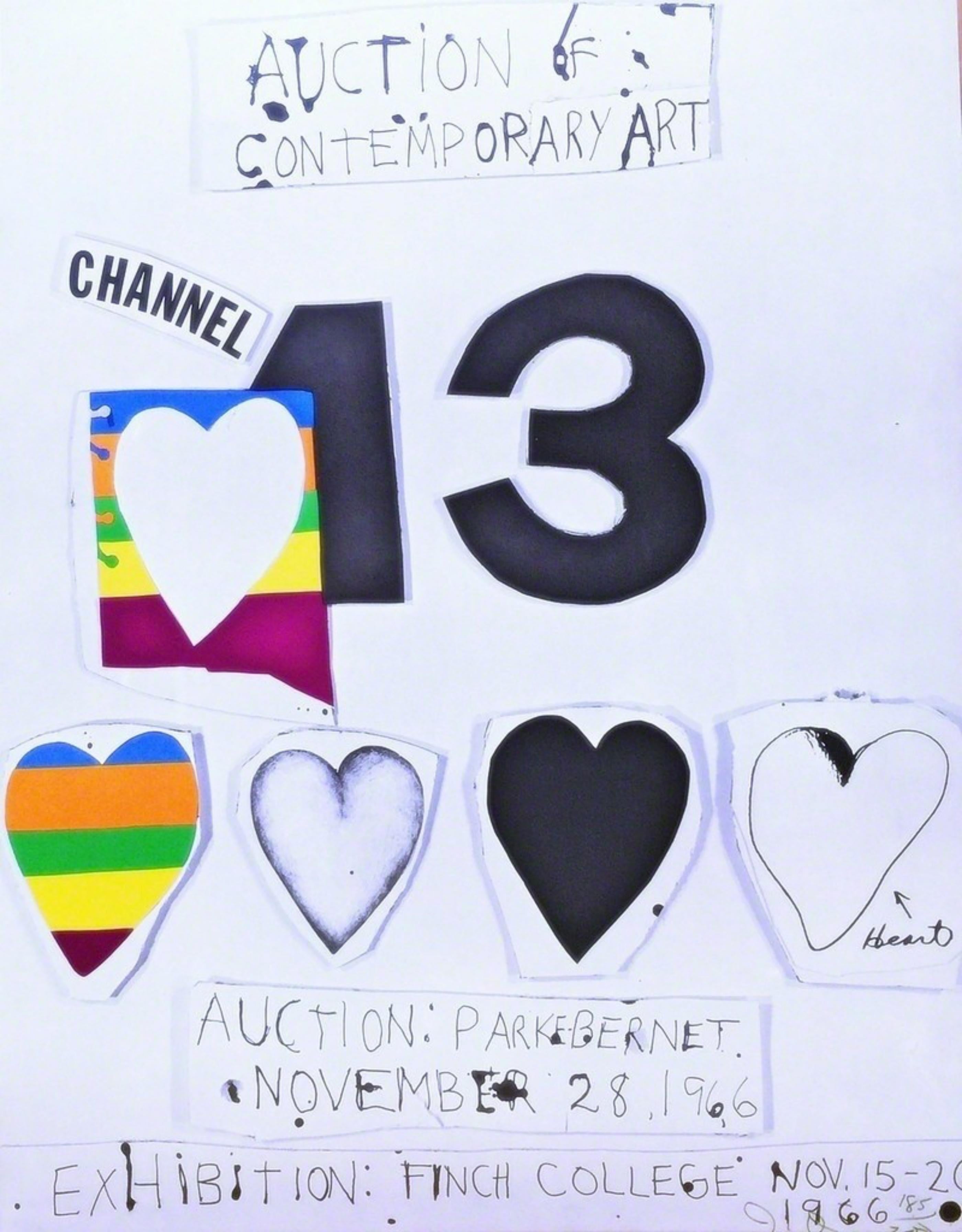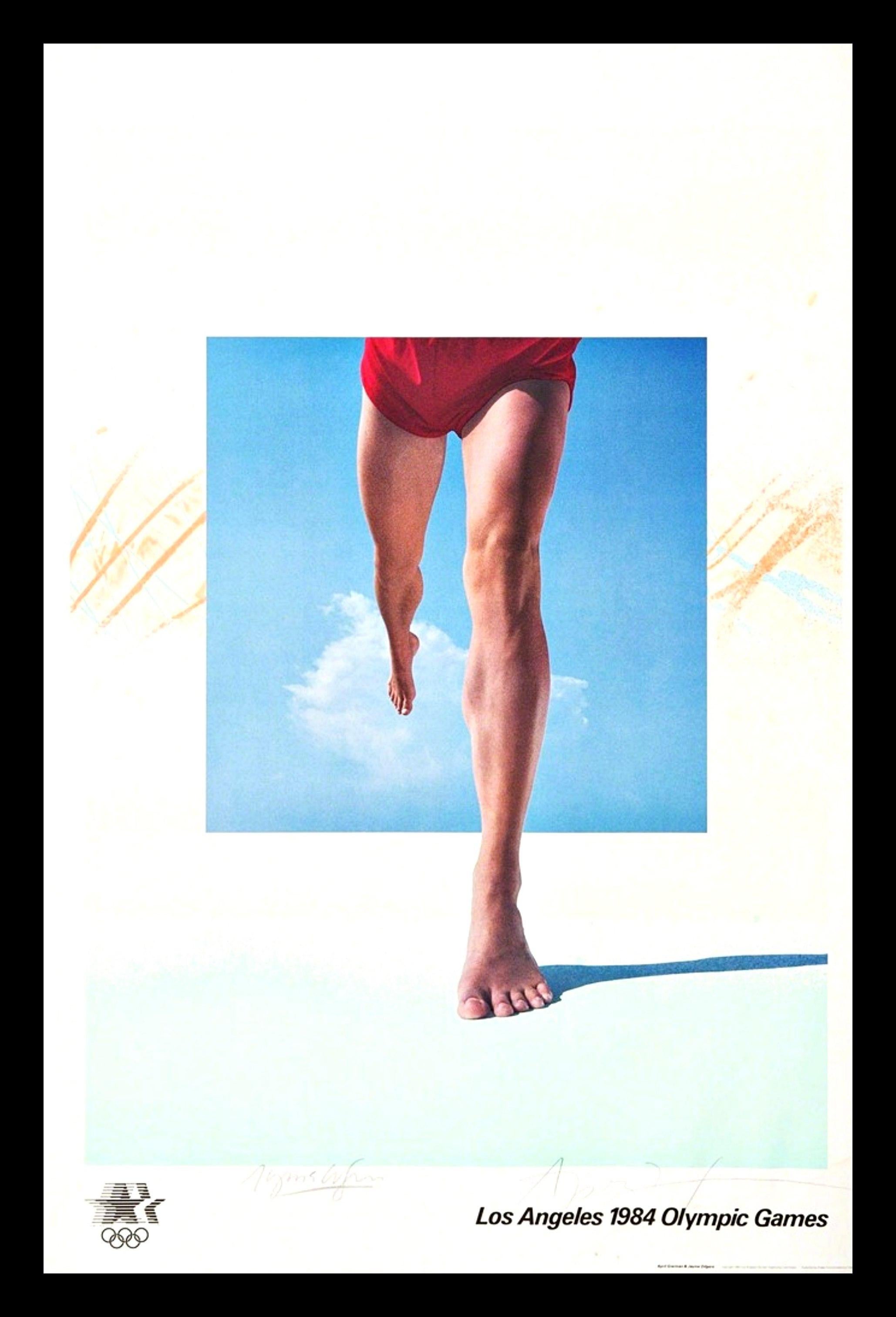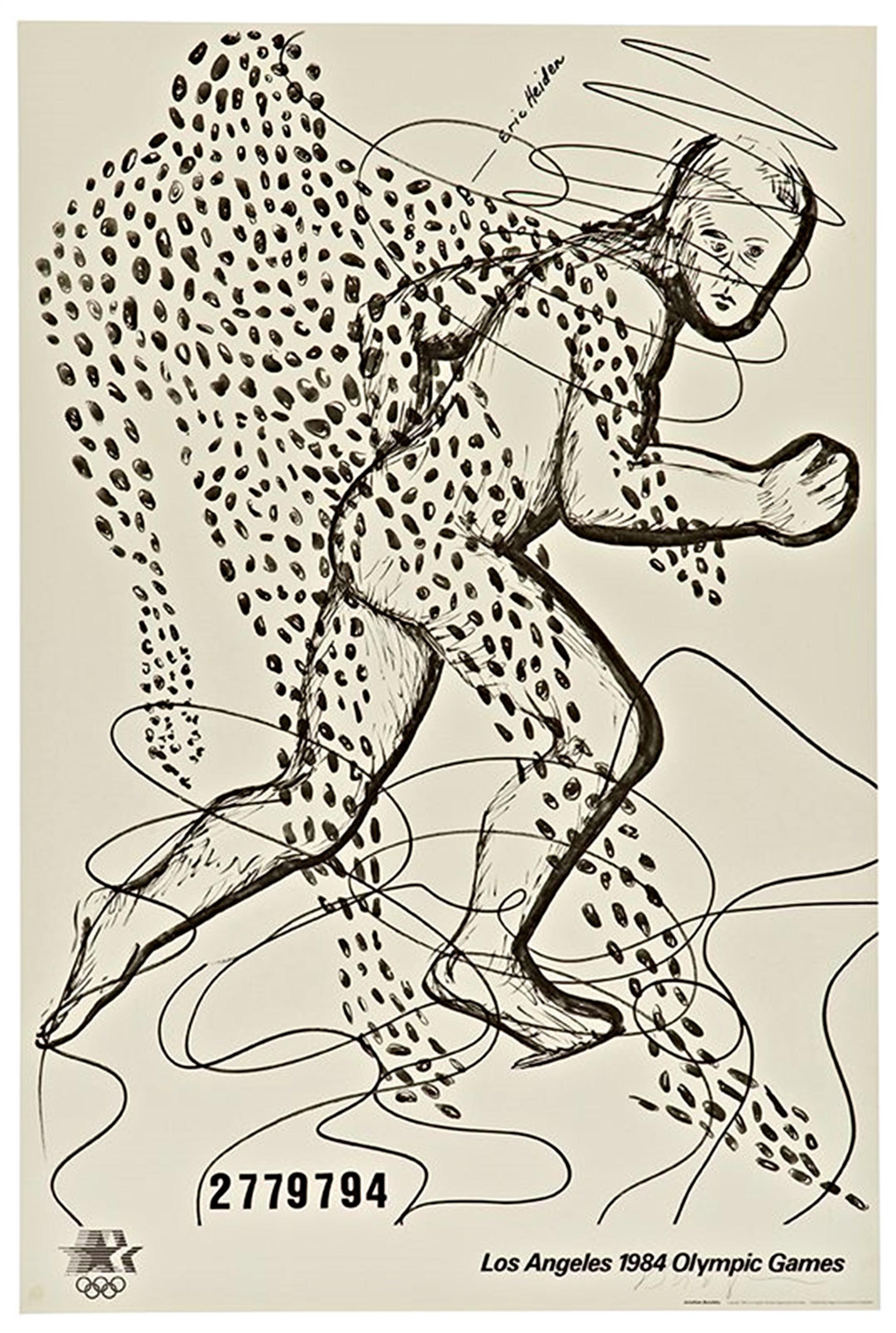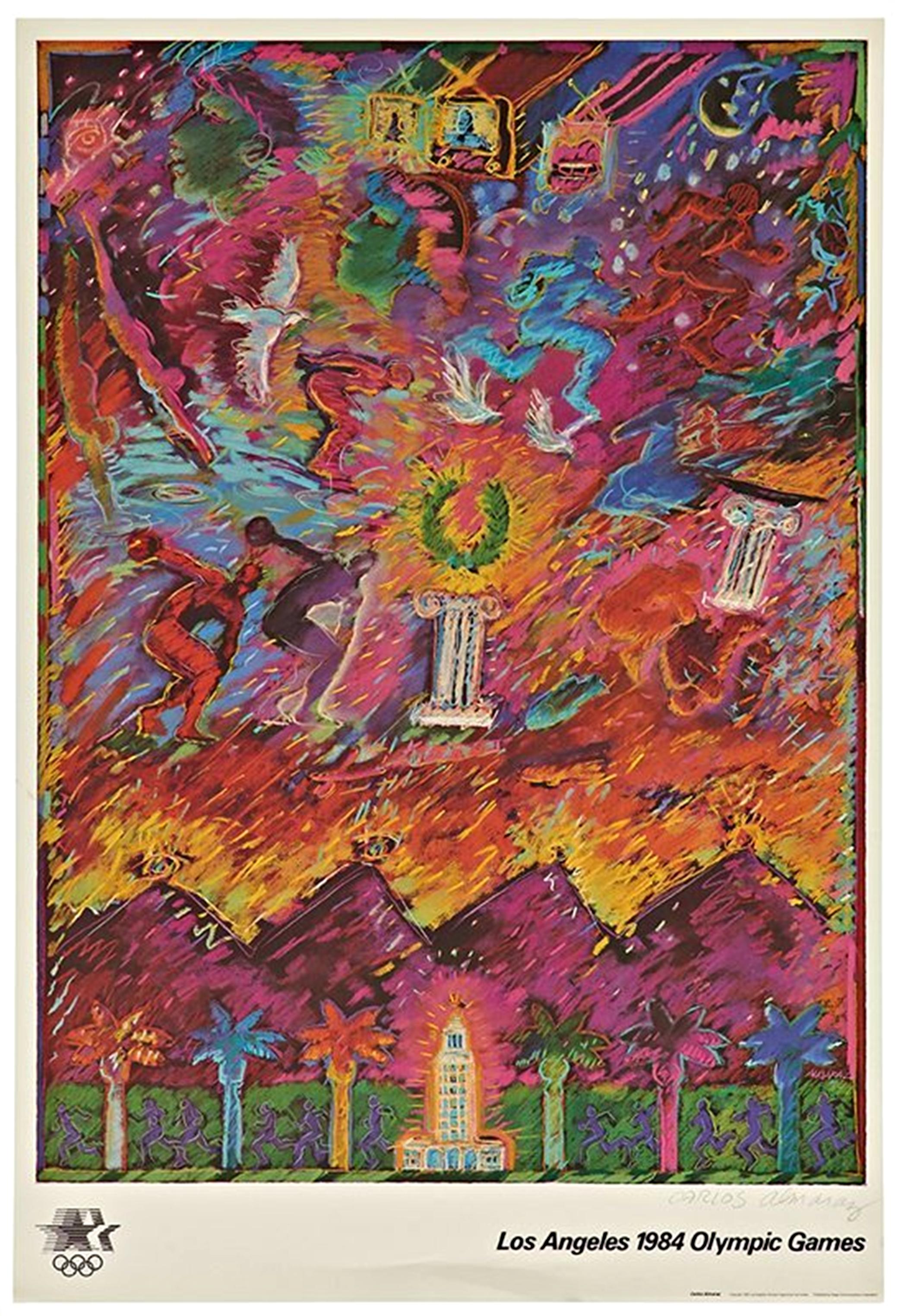Items Similar to A Maiakovski (For Mayakovsky) signed by Alechinsky & Christine Rochefort #10/50
Want more images or videos?
Request additional images or videos from the seller
1 of 8
Pierre AlechinskyA Maiakovski (For Mayakovsky) signed by Alechinsky & Christine Rochefort #10/50 1958
1958
About the Item
Pierre Alechinsky
A Maiakovski, 1958 (For Mayakovsky)
Color lithograph and offset lithograph with text
Pencil numbered 10/50 and signed by BOTH artist Pierre Alechinsky and writer Christiane Rochefort and numbered 10/50
Published by Imprimerie Gerard, Paris on the occasion of the exhibition "A Maiakovski" at Galerie D. Benador in Geneva, Switzerland
Lithographie en couleurs, réalisée à l'occasion de l'exposition «A. Maiakovski», signée par Alechinsky et Christiane Rochefort, numérotée 10/50
Frame included: held in the original brown wood vintage period frame
Pierre Alechinsky biography
Pierre Alechinsky was born on October 19, 1927 in Brussels. His father was Russian, his mother was Walloon and both were doctors. A painter, engraver and artist, he has lived and worked in France since 1951. Between 1944 and 1948 he studied typography and the illustration of books at the École nationale supérieure d'Architecture et des Arts Décoratifs (La Cambre, Brussels). At the same time, he started painting and joined the group of young Belgian painters (Jeune Peinture Belge) in 1947. In 1949, after meeting the poet Christian Dotremont, he joined the CoBrA (Copenhagen/Brussels/Amsterdam) group. In Brussels, on behalf of CoBrA, he founded a Research Center in a communal house, the Ateliers du Marais. In addition, he was involved in the eponymous magazine created by the group. In 1951, the year the movement was dissolved, he organized the second and final Cobra international exhibition of experimental art at the Palais des Beaux-Arts in Liège. After this, he left Brussels and moved to Paris where he perfected his etching technique at Atelier 17. In 1965, André Breton chose his work Central Park (1965) for L'éva absolu, XIe Exposition Internationale du Surréalisme at the Galerie de l' Eye, in Paris. This work was a turning point in his artistic career: it was his first acrylic painting with remarks in the margin, and represented an aerial view of Central Park interpreted by the artist with the appearance of a monster. Alechinsky gradually abandoned oils for this new medium which he used on paper mounted on canvas. From 1979, Pierre Alechinsky was represented by Galerie Maeght, which became Galerie Lelong (and is now Lelong & Co.). In 1982, he reversed the method used for Central Park. The central subject would be painted in black, while the margins, which until now had been used for drawings within its boundaries, would become a colorful border. He produced monumental works to order: The Reception room at the French Ministry of Culture (1985), the rotunda linking Hotel de Lassay with the French National Assembly (1993), or vast walls of enamelled lava (Belgium, Denmark). Over the years, many institutions have organized retrospectives of his work: the Carnegie Institute, Pittsburgh (1977), the MoMA, New York (1981), the Solomon R. Guggenheim Museum, New York (1986); the Galerie Nationale du Jeu de Paume, Paris (1998); the Center for Engraving and Printed Images, La Louvière (2000); the Graphic Art Cabinet of the Center Georges Pompidou, Paris (2004); the BNF, Paris (2005); the Granet Museum, Aix en Provence (2010); Círculo de Bellas Artes, Madrid (2015); the museums of Osaka and Tokyo (2016-2017). Pierre Alechinsky has received a number of prizes and awards: Young Belgian Painting (1950); Etching biennial, Kracow (1966); Triennial of Belgian Engraving (1966); Marzotto-Europe Grand Prix for painting (1968); Andrew W. Award Mellon (1976); Grand Prix national des Arts et Lettres for Painting (1984); Member of the Royal Academy of Belgium (1987); Commander of the Order of Arts and Letters (1992); Doctor Honoris Causa of the Free University of Brussels (1994); André Malraux Art Book Prize (2004); Doctor Honoris Causa of the University of Liège (2010); Praemium Imperiale, Japan (2018).
-Courtesy Galerie Lelong
More about Maiakovsky (Mayakovsky)
Few poets have led lives as tempestuous as that of Vladimir Mayakovsky. Born in 1893 and dead by his own hand in 1930, Mayakovsky packed his thirty-six years with drama, politics, passion, and―most important―poetry. An enthusiastic supporter of the Russian Revolution and the emerging Soviet State, Mayakovsky was championed by Stalin after his death and enshrined as a quasi-official Soviet poet, a position that led to undeserved neglect among Western literary scholars even as his influence on other poets has remained powerful.
- Publisher’s blurb for Bengt Jangfeldt’s first comprehensive biography of Mayakovsky,
Mayakovsky biography (translated)
Vladimir Mayakovsky was the leading Russian Futurist poet of the 20th century who created an entirely new form of Russian poetry loosely resembling such modern day rappers as Eminem and Snoop Dogg.
He was born Vladimir Vladimirovich Mayakovsky on July 19, 1893, in the town of Bagdadi, Kutaisi province in the Transcaucasian kingdom of Georgia, then part of Russian Empire (now Georgia). He was the last of three children in a Russian-Ukrainian family. His father, Vladimir Mayakovsky, was a Russian Cossack who worked for Imperial Ministry as a forest ranger. His mother, Alexandra Alekseevna, was Ukrainian. Young Mayakovsky grew up in a bilingual environment, his mother spoke Georgian while he learned Russian, and spent his childhood and boyhood attending a grammar school in Kutaisi, Georgia. In 1906, when Mayakovsky was 13, his father died of blood poisoning caused by a finger cut. Young Mayakovsky moved to Moscow with his mother and two sisters.
During his formative years Mayakovsky absorbed multi-cultural influences from Transcaucasia and Russia. From 1906 - 1908 he studied at Moscow Gymnasium, then dropped out and was involved in revolutionary movement with then underground Communist Party of Russia. Because of his association with communists, he was arrested three times, violated the prison rules, and spent over six months in Butyrskaya prison in Moscow. There he wrote his first poems while in a solitary cell in 1909. After his prison term, Mayakovsky refused to join the Communist Party, and for that Vladimir Lenin warranted his communist comrades that they should not trust Mayakovsky and should watch his activities and publications. During the 1910s Mayakovsky emerged as independent thinker and writer. He studied at Stroganov School of Art, then at Moscow Institute of Painting, Sculpture and Architecture. There he met Futurist artist David Burlyuk, and the two collaborated on several art shows and books.
In 1912, Mayakovsky moved to St. Petersburg, the capital famous for its wealth, cultural diversity, and cosmopolitan lifestyle. There he met Maxim Gorky who was instrumental with his initial steps and introductions. Mayakovsky wrote and directed his first play, a tragedy titled 'Vladimir Mayakovsky', that premiered at a St. Petersburg theatre in 1913. At that time, on a dacha in the Levashovo suburb of St. Petersburg, Mayakovsky met Lilya Brik, the woman who changed his life forever. She became his Muse, lover, and most trusted companion, while her husband, Osip Brik eventually became the publisher of Mayakovsky's most important works. In St. Petersburg Mayakovsky published his passionate poems: 'Cloud in the Trousers' (1915) and 'The Backbone Flute' (1916) alluding to his sexuality and the emerging menage à trois relationship with the Briks.
In the popular literary club "Brodyachaya Sobaka" (aka.. Wandering Dog) Mayakovsky met the aspiring poet Anna Akhmatova, her husband Nikolai Gumilev, and other important figures of the flourishing St. Petersburg cultural scene. Korney Ivanovich Chukovskiy, one of the leading writers in St. Petersburg, proclaimed Mayakovsky a genius, and promoted his poetry. However, during the 1914 - 1918, the disastrous First World War, two Russian revolutions, and the following Russian Civil War brought immense destruction, poverty, and instability. Mayakovsky was drafted and served in Petrograd Military Automobile School from 1915 to August 1917. After the Revolution of 1917, he remained in Petrograd (St. Petersburg) and was editor of Futurist paper as well as art magazines "Iskusstvo" and other projects.
In 1918 Mayakovsky made his film debut appearing in three silent films made at Neptun studio in St. Petersburg. He appeared as actor co-starring opposite Lilya Brik in Zakovannaya filmoi (1918), which he also wrote, and in Nye dlya deneg radivshisya (1918); both films were directed by Nikandr Turkin. Mayakovsky also co-starred in The Young Lady and the Hooligan (1918), which he also co-directed. At that time his stage-play 'Mystery-Bouffe' (1918) premiered at a St. Petersburg's theatre.
In mid-1919 he moved from St. Petersburg back to Moscow and shared a small room in a communal flat with his friend and lover Lilya Brik. For a while he worked as designer and poet for propaganda publications at ROSTA, the Russian Telegraph Agency. His circle in Moscow included such cultural figures as Osip Brik and Lilya Brik, as well as their friends: artists and filmmakers such as Sergei Eisenstein, and Alexander Rodchenko, writers Boris Pasternak and Viktor Shklovskiy among others. Mayakovsky and Brik published the avant-garde and leftist magazine 'LEF' together with Lev Kuleshov, Dziga Vertov and Sergei Yutkevich, where they opposed the mainstream official Soviet culture. Mayakovsky went to extremes, he called to trash all history and traditional culture, such as the 19th century writers Alexander Pushkin and Lev Tolstoy, as well as classical art. He also opposed the dull official "proletariat" propaganda and conformist Soviet mass-culture. His satirical plays 'Klop' (aka.. Bedbug) and 'Banya' (aka.. Bath) were staged by director Vsevolod Meyerhold, but soon were banned. Mayakovsky actively contributed to the emerging Russian-Soviet film industry as a writer, actor, and film director. He also co-wrote scenario for Lilya Brik's film Yevrei na zemle (1927).
During the 1920s, Mayakovsky traveled extensively in Europe and America, and amassed a significant cosmopolitan experience. In Paris he visited the studios of Pablo Picasso and Fernand Léger. In America Mayakovsky fathered a daughter, Patricia Tompson, form his relationship with Russian-American émigré Elli Jones (Elisaveta Petrovna). In Europe he had a relationship with another Russian emigrant actress. At that time he learned that most Russian writers and poets, such as Anastasiya Tsvetaeva, can not make money in the West. Back in Russia, he was so successful that he bought himself a new Renault car and hired a private chauffeur, comrade Gamazin, who was also a secret informant for Soviet Security agency.
By the late-1920s Mayakovsky emerged as a popular and influential figure in Soviet culture and politics; he was a poet, an artist, an actor, a writer, director and public speaker. His highly electrifying public performances often irritated the Soviet officials. Mayakovsky applied his untamed genius in almost every aspect of cultural and political life, and eventually became a much higher and bigger figure than the Soviet officialdom could tolerate. His non-conformist and non-Marxist position became a problem. For that reason he was under constant surveillance by the Soviet authorities.
Intellectuals regarded Mayakovsky for breaking all rules and traditions in literature, art and public life, and for exploding with his bold and highly original style of poetry. He was known for his passionate and intense public performances. He was also known for his hectic relationships with women. His personal life remained unstable for many years, as he was torn between several women in his life. On April 14, 1930, Mayakovsky was found dead, and his death was accompanied by a letter with a rather sarcastic message. The Soviet officials announced that Mayakovsky shot himself directly in his heart, because of his breakup with actress Veronika Polonskaya. Ten days after Mayakovsky's death the criminal investigator of the Mayakovsky's case was also shot dead.
Mayakovsky was buried in Novodevichy Cemetery in Moscow. Lilya Brik and her husband Osip Brik inherited the writer's archive. In 1935, five years after the death of Mayakovsky, Lily Brik wrote a letter to Iosif Stalin expressing her idea to publish the collected works of Mayakovsky. Stalin approved the Brik's idea, and ordered that Soviet publishers print collections of "revolutionary" poetry by Mayakovsky. Upon Stalin's instruction, Mayakovsky's "revolutionary" poetry was included in the Soviet school curriculum and reissued in massive printings.
Vladimir Mayakovsky was depicted in the film Mayakovsky itskeboda ase... (1958) by director Konstantine Pipinashvili, based on the autobiographical book "Ya -sam" (aka.. I-myself).
-Courtesy IMBD
-
- Creator:Pierre Alechinsky (1927, Belgian)
- Creation Year:1958
- Dimensions:Height: 21 in (53.34 cm)Width: 19 in (48.26 cm)Depth: 0.5 in (1.27 cm)
- Medium:
- Movement & Style:
- Period:
- Condition:Not examined outside of original vintage wood period frame but appears very good with no apparent issues.
- Gallery Location:New York, NY
- Reference Number:1stDibs: LU1745213761502
About the Seller
5.0
Platinum Seller
These expertly vetted sellers are 1stDibs' most experienced sellers and are rated highest by our customers.
Established in 2007
1stDibs seller since 2022
289 sales on 1stDibs
Typical response time: 1 hour
- ShippingRetrieving quote...Ships From: New York, NY
- Return PolicyA return for this item may be initiated within 1 day of delivery.
More From This SellerView All
- The Wrapped (MCA), Chicago 1969 (Limited Edition of 200, Hand Signed by Christo)By Christo and Jeanne-ClaudeLocated in New York, NYChristo and Jeanne-Claude The Wrapped (MCA), 1969 (Hand Signed), 2019 Four-color offset lithograph on 110 lb. Crane Lettra Cover stock, with an elegant gold foil stamp. Hand Signed by Christo 22 3/5 × 30 inches Edition of 200 Hand-signed by artist, Signed in graphite pencil by Christo on the front. Also elegant gold foil stamp. Unnumbered from the documented limited edition of only 200 Published by Museum of Contemporary Art, (MCA) Chicago Unframed A great gift for anyone with ties to Chicago! This limited-edition, hand signed offset lithograph on 110 lb. Crane Lettra Cover stock commemorates Christo's exhibition "Wrap In Wrap Out", which took place at the MCA’s original location on 237 East Ontario Street, Chicago. The project became the first public building Christo and his wife, Jeanne-Claude, wrapped in the United States. In an illuminating 2010 article entitled, "A daring plan to wrap a Chicago museum raises city ire – and makes art history," author Robin Amer recounts how Christo came to choose Chicago -- or rather how Chicago chose New York based artist Christo: "During a recent conversation he [Christo] ticked off the list of buildings he approached in downtown Manhattan starting in 1961. “Number 2 Broadway, number 20 Exchange Place,” he recalled. “We tried to wrap a building at Times Square. They all said no. Christo said he quickly realized that his best hope to wrap a building – his first in North America – would be to wrap a museum, which might be more amenable to his strange proposition.Christo and Jeanne-Claude approached New York’s Museum of Modern Art in 1967. The museum was interested, but Christo said they failed to secure permission for the show from the New York Fire...Category
1960s Pop Art Abstract Prints
MaterialsFoil
- Five Hearts for Channel 13 (Public Television), deluxe hand signed limited ed.By Jim DineLocated in New York, NYJim Dine Love for Channel 13 Lithograph. Hand signed and numbered recto 27 × 21 1/2 inches Edition 185/200 Signed and numbered 185/200 in graphite pencil on the recto Unframed Rarel...Category
1960s Pop Art Figurative Prints
MaterialsLithograph, Offset, Pencil
- Sister Corita (vintage hand signed poster) Images Gallery rarely found signedBy Corita KentLocated in New York, NYSister Mary Corita Kent Sister Corita hand signed poster, 1985 Offset Lithograph Signed in pencil by the artist on the lower right 24 x 18 inches Unframed This offset lithograph post...Category
1980s Pop Art Abstract Prints
MaterialsPencil, Lithograph, Offset
- 1984 Olympic Games Print (Hand Signed by both April Greiman and Jayme Odgers)By April GreimanLocated in New York, NYApril Greiman 1984 Olympic Games Print (Hand Signed by both April Greiman and Jayme Odgers), 1982 Offset Lithograph Poster Signed in graphite pencil on the front. Accompanied by a letter of authenticity from the publisher 36 x 24 inches Unframed Accompanied by a letter of authenticity from the publisher on Olympic letterhead. This is one of 750 hand signed lithographic posters (though fewer than 200 said to be extant), published in 1982 to celebrate the 1984 Los Angeles Olympics . The Olympic Committee commissioned 15 nationally known artists, including April Greiman and Jayme Odgers to create unique designs to promote the event. The complete list of artists is: Sam Francis, David Hockney, Richard Diebenkorn, Carlos Almaraz, Robert Rauschenberg, Jennifer Bartlett, Jonathon Borofsky, Roy LIchtenstein, April Gornik, Raymond Saunders, Martin Puryear, John Baldessari, Lynda Benglis, Billy Al Bengston and Garry Winogrand. This was Greiman and Odger's contribution to the portfolio. In 2017, the Olympic Museum in Lausanne Switzerland...Category
1980s Realist Figurative Prints
MaterialsLithograph, Pencil, Offset
- 2779494: The Olympic Runner (Limited Ed. Hand Signed with Olympic Committee COA)By Jonathan BorofskyLocated in New York, NYJonathan Borofsky 2779494: The Olympic Runner Los Angeles 1984 Olympic Games (Hand Signed with Olympic Committee COA), 1982 Offset Lithograph on Parson'...Category
1980s Contemporary Figurative Prints
MaterialsLithograph, Offset, Pencil
- Los Angeles 1984 Olympic Games poster hand signed Edition 750 w/Olympic COABy Carlos AlmarazLocated in New York, NYCarlos Almaraz Los Angeles 1984 Olympic Games (with COA from Olympic Committee), 1982 Offset Lithograph on Parson's Diploma paper, accompanied by COA from Olympic Committee. Signed i...Category
1980s Contemporary Abstract Prints
MaterialsLithograph, Offset, Pencil
You May Also Like
- POISEBy Robert RauschenbergLocated in Aventura, FLOffset lithograph in colors. Hand signed, dated and numbered by the artist. Artwork is in excellent condition. Certificate of authenticity included. Edition of 48. All reasonable off...Category
1990s Modern Abstract Prints
MaterialsOffset, Paper, Lithograph
- DEMOCRATIC PARTY HUMAN RIGHTS DINNERBy Robert RauschenbergLocated in Aventura, FLOffset lithograph on hodgkins handmade paper. Hand signed and numbered in pencil by the artist. Certificate of authenticity included. Edition of 100. Framed. All reasonable offers w...Category
1980s Modern Abstract Prints
MaterialsHandmade Paper, Lithograph, Offset
- Paris Review PosterBy Robert RauschenbergLocated in New York, NYA very good impression of this early color offset lithograph on white wove paper. Signed, dated and numbered 8/150 in felt-tip pen and black ink by Rauschenberg...Category
1960s Modern Abstract Prints
MaterialsColor, Lithograph, Offset
- French Modernist Mourlot Lithograph Vintage Air France Poster Roger BezombesBy Roger BezombesLocated in Surfside, FLVintage French Travel Poster, Air France Roger Bezombes (1913-1994) French Bezombes was a painter, sculptor, medalist, and designer. He studied in Paris, at the École des Beaux-Arts, and was much influenced by his friendship with Maurice Denis. Heavily influenced by surrealism, He worked principally as a painter, adopting the saturated Fauvist colors of Henri Matisse in landscapes and figure studies often based on observation of “exotic” cultures, notably Mediterranean and North African. Constrained, because a very young orphan, to all kinds of professions which provide him with the material means to devote himself to painting - he participated in 1930 in the installation of the exhibition of the Bauhaus at the Grand Palais-, Roger Bezombes is student of the National School of Fine Arts in Paris. (Ecole des Beaux Artes) He was trained in the art of fresco by Paul Baudoüin, René Barotte nonetheless restores that the young man's preference goes to the practice of "truancy" which he uses to make copies at the Louvre Museum. It’s the time when Paul Gauguin’s paintings, Vincent Van Gogh and Henri Matisse are revealed to him by Maurice Denis with whom he will remain close until his accidental death, painting him on his funeral bed on November 14, 1943. He executed surrealist tapestry designs for Aubusson and Gobelin tapestries, posters (winning the Grand Prix de l'Affiche Francaise in 1984), costumes and sets for ballets at the Metropolitan Opera House in New York, reliefs and murals. In 1965 he took up medal-making, expressing in his numerous metallic works for the Paris Mint that obsession with found objects which is also evident in his large-scale sculpture and in his posters. He designed posters for Air France and for the French national railways. Roger Bezombes went to Africa for the first time in 1936 thanks to a travel grant and received the same year the second grand prize of Rome . In 1937 he traveled around Morocco where he became friends with Albert Camus. The year 1938 offered him both his first solo exhibition at the Charpentier gallery in Paris with paintings and gouaches on the theme of Morocco and the attribution of the national grand prize for the arts, earning him a great journey which , from Dakar to Algiers , takes it through Chad , Tamanrasset and Hoggar. Roger Bezombes became a professor at the Julian Academy in 1950. For him, 1951 was the year of a trip to Greece and the year where he began his relationship with tapestry work. Roger Bezombes visited Israel in 1953, Tunisia and Egypt in 1954. He was appointed official painter of the Navy in 1955. Pierre Mazars analyzes that “after a period where we notice the influence of Van Gogh and GeorgesBraque, particularly in his landscapes of Provence, he came to a more schematic writing, the colored spots and the thicknesses of material taking more of importance as the subject. He even performed composite works, half-watercolors, half-pasted papers, in which he incorporated pieces of newspapers”. He was elected titular to the Academy of Overseas Sciences in 1978. "The range of Bezombes' talent forms is remarkable,” writes Lynne Thornton, “ranging from paintings, murals, travel posters, tapestry cartons, book illustrations, monumental ceramic decorations, ballet and theater sets, totem sculptures, sculpture objects, jewelry and medallions”. He was part of the mid century mod School of Paris that included Leon Zack, Bernard Lorjou, Paul Augustin Aizpiri, Gabriel Godard, Michel Henry, Hans Erni, Bengt Lindstrom, Alfred Manessier, Andre Hambourg, Raymond Legueult and Jean Rigaud. Select Solo Exhibitions: 1938: Galerie Charpentier, Paris 1950, '53, '55, '57: Galerie Andre Weil, Paris 1953:Wildenstein Gallery, London 1954: Institut Francais, Cologne 1956: Galerie Matarasso, Nice 1957: Horn Gallery, Luxembourg; Guilde de la Gravure, Paris 1958: Denys-Puech Museum, Rodez 1962: Musee de l'Athenee, Geneva; Chateau Grimaldi, Cagnes-sur-Mer 1966: Galerie des Ponchettes, Nice 1967: Galerie Martel, Montreal 1968: Romanet-Vercel Gallery, New York; Reattu Museum, Arles; Le Corbusier Center, Firminy 1969: Galerie Philippe...Category
1980s Modern Abstract Prints
MaterialsOffset, Lithograph
- French Modernist Mourlot Lithograph Vintage Air France Poster Roger BezombesBy Roger BezombesLocated in Surfside, FLVintage French Travel Poster, Air france Roger Bezombes (1913-1994) French Bezombes was a painter, sculptor, medalist, and designer. He studied in Paris, at the École des Beaux-Arts, and was much influenced by his friendship with Maurice Denis. Heavily influenced by surrealism, He worked principally as a painter, adopting the saturated Fauvist colors of Henri Matisse in landscapes and figure studies often based on observation of “exotic” cultures, notably Mediterranean and North African. Constrained, because a very young orphan, to all kinds of professions which provide him with the material means to devote himself to painting - he participated in 1930 in the installation of the exhibition of the Bauhaus at the Grand Palais-, Roger Bezombes is student of the National School of Fine Arts in Paris. (Ecole des Beaux Artes) He was trained in the art of fresco by Paul Baudoüin, René Barotte nonetheless restores that the young man's preference goes to the practice of "truancy" which he uses to make copies at the Louvre Museum. It’s the time when Paul Gauguin’s paintings, Vincent Van Gogh and Henri Matisse are revealed to him by Maurice Denis with whom he will remain close until his accidental death, painting him on his funeral bed on November 14, 1943. He executed surrealist tapestry designs for Aubusson and Gobelin tapestries, posters (winning the Grand Prix de l'Affiche Francaise in 1984), costumes and sets for ballets at the Metropolitan Opera House in New York, reliefs and murals. In 1965 he took up medal-making, expressing in his numerous metallic works for the Paris Mint that obsession with found objects which is also evident in his large-scale sculpture and in his posters. He designed posters for Air France and for the French national railways. Roger Bezombes went to Africa for the first time in 1936 thanks to a travel grant and received the same year the second grand prize of Rome . In 1937 he traveled around Morocco where he became friends with Albert Camus. The year 1938 offered him both his first solo exhibition at the Charpentier gallery in Paris with paintings and gouaches on the theme of Morocco and the attribution of the national grand prize for the arts, earning him a great journey which , from Dakar to Algiers , takes it through Chad , Tamanrasset and Hoggar. Roger Bezombes became a professor at the Julian Academy in 1950. For him, 1951 was the year of a trip to Greece and the year where he began his relationship with tapestry work. Roger Bezombes visited Israel in 1953, Tunisia and Egypt in 1954. He was appointed official painter of the Navy in 1955. Pierre Mazars analyzes that “after a period where we notice the influence of Van Gogh and GeorgesBraque, particularly in his landscapes of Provence, he came to a more schematic writing, the colored spots and the thicknesses of material taking more of importance as the subject. He even performed composite works, half-watercolors, half-pasted papers, in which he incorporated pieces of newspapers”. He was elected titular to the Academy of Overseas Sciences in 1978. "The range of Bezombes' talent forms is remarkable,” writes Lynne Thornton, “ranging from paintings, murals, travel posters, tapestry cartons, book illustrations, monumental ceramic decorations, ballet and theater sets, totem sculptures, sculpture objects, jewelry and medallions”. He was part of the mid century mod School of Paris that included Leon Zack, Bernard Lorjou, Paul Augustin Aizpiri, Gabriel Godard, Michel Henry, Hans Erni, Bengt Lindstrom, Alfred Manessier, Andre Hambourg, Raymond Legueult and Jean Rigaud. Select Solo Exhibitions: 1938: Galerie Charpentier, Paris 1950, '53, '55, '57: Galerie Andre Weil, Paris 1953:Wildenstein Gallery, London 1954: Institut Francais, Cologne 1956: Galerie Matarasso, Nice 1957: Horn Gallery, Luxembourg; Guilde de la Gravure, Paris 1958: Denys-Puech Museum, Rodez 1962: Musee de l'Athenee, Geneva; Chateau Grimaldi, Cagnes-sur-Mer 1966: Galerie des Ponchettes, Nice 1967: Galerie Martel, Montreal 1968: Romanet-Vercel Gallery, New York; Reattu Museum, Arles; Le Corbusier Center, Firminy 1969: Galerie Philippe...Category
1980s Modern Abstract Prints
MaterialsLithograph, Offset
- Alexander Calder lithograph derrière le miroirBy Alexander CalderLocated in NEW YORK, NYAlexander Calder Lithograph c. 1971 from Derrière le miroir: Lithograph in colors; 15 x 11 inches. Very good overall vintage condition; well-preseved. Unsigned from an edition of u...Category
1970s Abstract Abstract Prints
MaterialsLithograph, Offset
